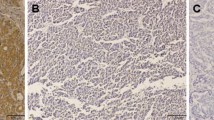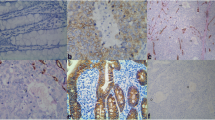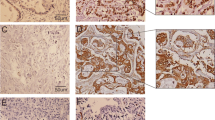Abstract
Caveolin-1 is the major structural protein in caveolae, implicated in oncogenesis and angiogenesis. The connections between caveolin-1 and progression and angiogenesis of hepatocellular carcinoma (HCC) is still not clear. Thus we investigated the relationship of caveolin-1 expression, vascular endothelial growth factor (VEGF) expression, microvessel density (MVD), and unpaired artery (UA) with the clinicopathologic features of patients with HCC. Formalin-fixed, paraffin-embedded tissue sections of HCC from 75 patients who had undergone an initial hepatectomy were stained immunohistochemically with specific antibodies against caveolin-1, VEGF, CD34 and α-SMA. The levels of caveolin-1, VEGF, MVD and UA were correlated with the clinicopathologic variables, and tissue sections were also analyzed by dual-label immunofluorescence. We found that increased expression of caveolin-1 was associated with metastasis and with a worse prognosis of HCC. Caveolin-1 expression correlates positively with VEGF, MVD and UA. These results suggest that caveolin-1 may play an important role in the progression of HCC and angiogenesis.



Similar content being viewed by others
Abbreviations
- HCC:
-
hepatocellular carcinoma
- MVD:
-
microvessel density
- UA:
-
unpaired artery
- VEGF:
-
vascular endothelial growth factor
- α-SMA:
-
alpha smooth muscle actin
- SECs:
-
sinusoidal endothelial cells
- MDN:
-
macroregenerative and dysplastic nodules
References
Okamoto T, Schlegel A, Scherer PE, Lisanti MP (1998) Caveolins, a family of scaffolding proteins for organizing “preassembled signaling complexes” at the plasma membrane. J Biol Chem 273:5419–5422
Wikman H, Kettunen E, Seppänen JK, Karjalainen A, Hollmén J, Anttila S, Knuutila S (2002) Identification of differentially expressed genes in pulmonary adenocarcinoma by using cDNA array. Oncogene 21:5804–5813
Wiechen K, Sers C, Agoulnik A, Arlt K, Dietel M, Schlag PM, Schneider U (2001) Down-regulation of caveolin-1, a candidate tumor suppressor gene, in sarcomas. Am J Pathol 158:833–839
Kato K, Hida Y, Miyamoto M, Hashida H, Shinohara T, Itoh T, Okushiba S, Kondo S, Katoh H (2002) Overexpression of caveolin-1 in esophageal squamous cell carcinoma correlates with lymph node metastasis and pathologic stage. Cancer 94:929–933
Suzuoki M, Miyamoto M, Kato K, Hiraoka K, Oshikiri T, Nakakubo Y, Fukunaga A, Shichinohe T, Shinohara T, Itoh T, Kondo S, Katoh H (2002) Impact of caveolin-1 expression on prognosis of pancreatic ductal adenocarcinoma. Br J Cancer 87:1140–1144
Rajjayabun PH, Garg S, Durkan GC, Charlton R, Robinson MC, Mellon JK (2001) Caveolin-1 expression is associated with high-grade bladder cancer. Urology 58:811–814
Dewever J, Frérart F, Bouzin C, Baudelet C, Ansiaux R, Sonveaux P, Gallez B, Dessy C, Feron O (2007) Caveolin-1 is critical for the maturation of tumor blood vessels through the regulation of both endothelial tube formation and mural cell recruitment. Am J Pathol 171:1619–1628
Joo HJ, Oh DK, Kim YS, Lee KB, Kim SJ (2004) Increased expression of caveolin-1 and microvessel density correlates with metastasis and poor prognosis in clear cell renal cell carcinoma. BJU Int 93:291–296
Anders RA, Yerian LM, Tretiakova M, Davison JM, Quigg RJ, Domer PH, Hoberg J, Hart J (2003) cDNA microarray analysis of macroregenerative and dysplastic nodules in end-stage hepatitis C virus-induced cirrhosis. Am J Pathol 162:991–1000
Hirasawa Y, Arai M, Imazeki F, Tada M, Mikata R, Fukai K, Miyazaki M, Ochiai T, Saisho H, Yokosuka O (2006) Methylation status of genes upregulated by demethylating agent 5-aza-2′-deoxycytidine in hepatocellular carcinoma. Oncology 71:77–85
Zhou H, Jia L, Wang S, Wang H, Chu H, Hu Y, Cao J, Zhang J (2006) Divergent expression and roles for caveolin-1 in mouse hepatocarcinoma cell lines with varying invasive ability. Biochem Biophys Res Commun 345:486–494
Choi HN, Kim KR, Park HS, Jang KY, Kang MJ, Lee DG, Kim YK, Cho BH, Cha EJ, Moon WS (2007) Expression of caveolin in hepatocellular carcinoma: association with unpaired artery formation and radiologic findings. Korean J Hepatol 13:396–408
Park SS, Kim JE, Kim YA, Kim YC, Kim SW (2005) Caveolin-1 is down-regulated and inversely correlated with HER2 and EGFR expression status in invasive ductal carcinoma of the breast. Histopathology 47:625–630
Tanigawa N, Lu C, Mitsui T, Miura S (1997) Quantitation of sinusoid-like vessels in hepatocellular carcinoma: its clinical and prognostic significance. Hepatology 26:1216–1223
Glenney JR Jr (1989) Tyrosine phosphorylation of a 22-kDa protein is correlated with transformation by Rous sarcoma virus. J Biol Chem 264:20163–20166
Williams TM, Medina F, Badano I, Hazan RB, Hutchinson J, Muller WJ, Chopra NG, Scherer PE, Pestell RG, Lisanti MP (2004) Caveolin-1 gene disruption promotes mammary tumorigenesis and dramatically enhances lung metastasis in vivo. J Biol Chem 279:51630–51646
Yang G, Addai J, Wheeler TM, Frolov A, Miles BJ, Kadmon D, Thompson TC (2007) Correlative evidence that prostate cancer cell-derived caveolin-1 mediates angiogenesis. Hum Pathol 38:1688–1695
Barresi V, Cerasoli S, Paioli G, Vitarelli E, Giuffrè G, Guiducci G, Tuccari G, Barresi G (2006) Caveolin-1 in meningiomas: expression and clinico-pathological correlations. Acta Neuropathol 112:617–626
Bailey KM, Liu J (2008) Caveolin-1 up-regulation during epithelial to mesenchymal transition is mediated by focal adhesion kinase. J Biol Chem 283:13914–13724
Barresi V, Cerasoli S, Tuccari G (2008) Correlative evidence that tumor cell-derived caveolin-1 mediates angiogenesis in meningiomas. Neuropathology 28:472–478
Yerian LM, Anders RA, Tretiakova M, Hart J (2004) Caveolin and thrombospondin expression during hepatocellular carcinogenesis. Am J Surg Pathol 28:357–364
Mitsuhashi N, Shimizu H, Ohtsuka M, Wakabayashi Y, Ito H, Kimura F, Yoshidome H, Kato A, Nukui Y, Miyazaki M (2003) Angiopoietines and Tie-2 expression in angiogenesis and proliferation of human hepatocellular carcinoma. Hepatology 37:1105–1113
Morinaga S, Imada T, Shimizu A, Akaike M, Sugimasa Y, Takemiya S, Takanashi Y (2001) Angiogenesis in hepatocellular carcinoma as evaluated by alpha smooth muscle actin immunohistochemistry. Hepatogastroenterology 48:224–228
Liu J, Wang XB, Park DS, Lisanti MP (2002) Caveolin-1 expression enhances endothelial capillary tubule formation. J Biol Chem 277:10661–10668
Griffoni C, Spisni E, Santi S, Riccio M, Guarnieri T, Tomasi V (2000) Knockdown of caveolin-1 by antisense oligonucleotides impairs angiogenesis in vitro and in vivo. Biochem Biophys Res Commun 276:756–761
Podar K, Shringarpure R, Tai YT, Simoncini M, Sattler M, Ishitsuka K, Richardson PG, Hideshima T, Chauhan D, Anderson KC (2004) Caveolin-1 is required for vascular endothelial growth factor-triggered multiple myeloma cell migration and is targeted by bortezomib. Cancer Res 64:7500–7506
Acknowledgements
Special thanks to Dr. Lin-Ying Chen for technical assistance.
Author information
Authors and Affiliations
Corresponding author
Rights and permissions
About this article
Cite this article
Zhang, ZB., Cai, L., Zheng, SG. et al. Overexpression of Caveolin-1 in Hepatocellular Carcinoma with Metastasis and Worse Prognosis: Correlation with Vascular Endothelial Growth Factor, Microvessel Density and Unpaired Artery. Pathol. Oncol. Res. 15, 495–502 (2009). https://doi.org/10.1007/s12253-008-9144-7
Received:
Accepted:
Published:
Issue Date:
DOI: https://doi.org/10.1007/s12253-008-9144-7




